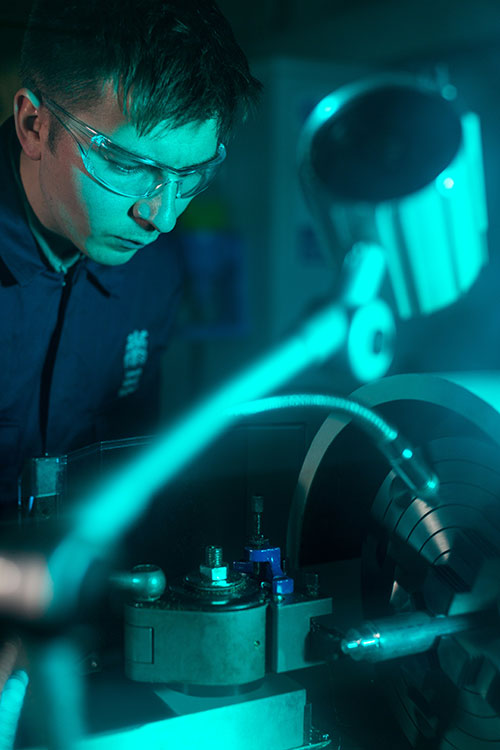
What is Non-Destructive Testing (NDT)?
Non-Destructive Testing (NDT) is a group of testing techniques used to evaluate the properties of a material, component, structure, or system without causing damage. NDT is widely used in industries such as aerospace, construction, manufacturing, and oil and gas to detect defects, ensure quality, and improve safety.
Types of NDT Methods
Visual Testing (VT) – Examines surface flaws using direct or remote visual inspection.
Ultrasonic Testing (UT) – Uses high-frequency sound waves to detect internal defects.
Radiographic Testing (RT) – Utilizes X-rays or gamma rays to inspect internal structures.
Magnetic Particle Testing (MT) – Detects surface and near-surface defects in ferromagnetic materials using a magnetic field.
Liquid Penetrant Testing (PT) – Uses a liquid dye to identify surface cracks and discontinuities.
Eddy Current Testing (ECT) – Employs electromagnetic induction to find surface and sub-surface defects in conductive materials.
Acoustic Emission Testing (AET) – Monitors high-frequency stress waves produced by material deformation or crack growth.
Career in NDT
Job Roles
- NDT Technician – Performs inspections using various NDT methods.
- NDT Inspector – Ensures compliance with industry standards and regulations.
- NDT Engineer – Develops testing procedures and interprets results.
- Quality Control (QC) Inspector – Oversees production and quality assurance processes.
Industries Hiring NDT Professionals
- Aerospace
- Automotive
- Construction
- Manufacturing
- Oil & Gas
- Power Generation
- Rail & Transportation
Required Certifications
Certifications vary by country and industry. Some common ones include:
- ASNT (American Society for Nondestructive Testing) Certification (Levels I, II, III)
- PCN (Personnel Certification in NDT) – Europe
- ISO 9712 Certification
- CSWIP (Certification Scheme for Welding Inspection Personnel)
Frequently Asked Questions (FAQ)
1. Do I need a degree to work in NDT?
No, but having a background in engineering, physics, or materials science can be beneficial. Many NDT professionals enter the field through vocational training and certification programs.
2. How do I become certified in NDT?
Certification typically requires training, hands-on experience, and passing an exam. The requirements depend on the certification body (e.g., ASNT, PCN, ISO 9712).
3. Is NDT a physically demanding job?
Yes, NDT technicians often work in challenging environments, such as confined spaces, heights, or extreme temperatures. However, roles like NDT engineers or analysts involve more office-based work.
4. What skills are essential for an NDT professional?
- Attention to detail
- Analytical thinking
- Technical proficiency with NDT equipment
- Strong understanding of materials and engineering principles
- Good communication skills for reporting and documentation
5. Are there opportunities for career growth in NDT?
Yes, professionals can advance from technician to inspector, engineer, and even to Level III certification, allowing them to develop procedures, train others, and take on leadership roles.
6. What are the risks involved in NDT?
Some methods, like radiographic testing, involve exposure to radiation, but strict safety protocols minimize risks. Proper training and adherence to safety standards are crucial.
7. What industries offer the highest-paying NDT jobs?
Oil & Gas, Aerospace, and Nuclear industries typically offer higher salaries due to the complexity and critical nature of inspections.
Related Article:
How to Become a NDT Technician

Salary and Job Outlook
Salaries vary based on location, experience, and certification level. Entry-level NDT technicians can earn around $40,000-$60,000 per year, while experienced Level III NDT professionals can make over $100,000 annually. The job outlook is positive, with increasing demand for skilled NDT professionals in various industries.
Non-Destructive Testing is a rewarding career with opportunities in multiple industries
With the right training, certification, and experience, professionals in this field can enjoy job stability, career growth, and competitive salaries.

Continue Reading: Articles and blog posts on Non-Destructive Testing (NDT):
These resources offer valuable insights into the latest developments, techniques, and applications of Non-Destructive Testing across various industries.
“Advances in Non-Destructive Testing Methods”
This article discusses various NDT methods that detect both external and internal defects in structures without interfering with their integrity. • Learn More
“Non-Destructive Testing (NDT): Types and Techniques”
An overview of different NDT methods and their applications across various industries, highlighting the importance of preserving material integrity during testing. • Learn More
“Ultimate Guide to NDT: Methods, Tools, and Applications”
This comprehensive guide explores essential NDT techniques that ensure safety and integrity in various industries without causing damage. • Learn More
“Destructive vs. Non-Destructive Testing in Manufacturing”
A comparative analysis of destructive and non-destructive testing methods, focusing on how NDT techniques assess component quality without causing harm.• Learn More
“NDT | An Open Access Journal from MDPI”
An international, peer-reviewed, open-access journal on non-destructive testing, publishing quarterly and covering a wide range of NDT topics and research. • Learn More
“World Of NDT – A Blog For Non Destructive Testing”
A blog dedicated to NDT, featuring articles on various testing methods, industry news, and insights into the latest trends and technologies in non-destructive testing. • Learn More
